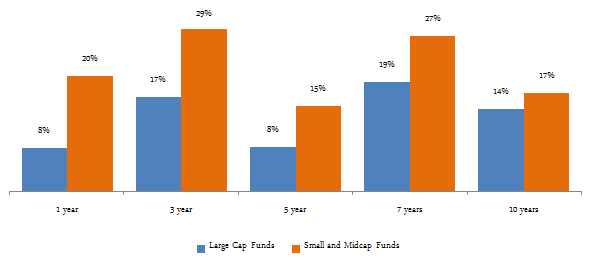Should you invest in large cap or midcap mutual funds

One of the most frequently asked questions that I have heard being asked several times in investment conferences that I attended over the past few years is, whether small and midcap funds are more suitable than large cap funds and vice versa? The responses to the same question have been varied over the years. Back in 2013, investment experts advocated investing in small and midcap funds because the valuation gap between large cap and midcap stocks was quite substantial back then. In more recent months, the response from investment experts is different. Small and midcap stocks, they say, have run up quite a lot and the valuation gap does not exist now. As per an Economic Times report a few days back, two years back the average Price Earnings ratio (P/E) of large cap stocks was around 15 while that of midcap stocks was around 10, whereas now average P/E of large cap stocks is around 21 while that of midcap stocks is around 24. The valuation catch-up is evident in the chart below, which shows the average annual returns of large cap and midcap funds from 2010 onwards.
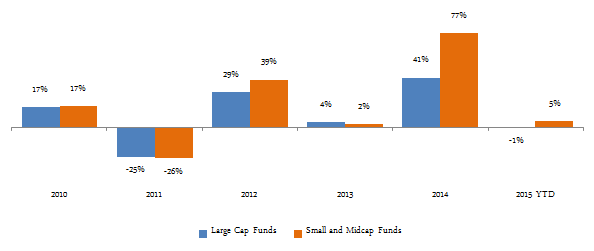
The chart below shows the growth of र 100,000 investments made on January 1 2010, in an average large cap and small and midcap fund respectively.
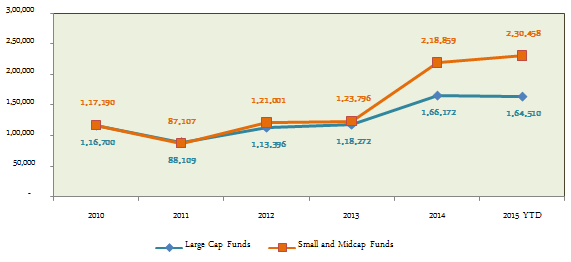
Clearly, your small and midcap fund investment would have yielded higher returns over the last 3 to 5 years compared to a large cap fund investment. However, you surely must have read the disclaimer put out by all mutual funds that, past performance is not necessarily an indicator of future performance.
Different periods says different story
The chart below shows the average annual returns of large cap and midcap funds from 2006 to 2011.
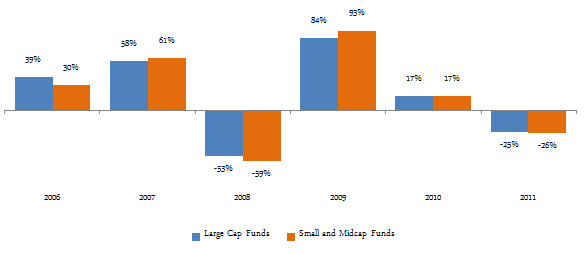
The chart below shows the growth of र 100,000 investments made on January 1 2006, in an average large cap and midcap fund respectively from 2006 to 2011.
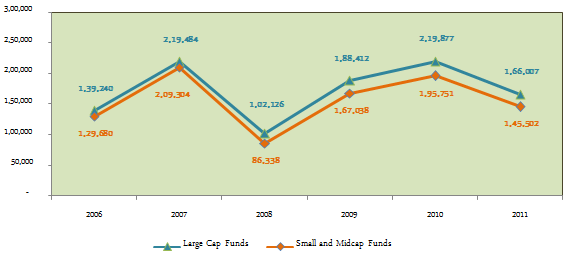
It is clear from the chart above that, large cap funds outperformed midcap funds during this period. Midcap funds underperformed large cap funds because they were worse affected in the bear market periods in 2008 and again in 2011, despite outperforming large cap funds in most bull market years over the 2006 to 2011 period. Market conditions affect different market segments differently and it is quite possible that large cap funds may outperform midcap funds in the near term, because of factors related to valuations discussed earlier.
So what should you do? Should you switch from midcap funds to large cap funds now? The answer is not so simple.
Differences between a large cap and small and midcap fund
Investors should understand key differences between large cap and small and midcap funds, so that they are able to make the best decision to meet their own financial planning objectives.
- As the name suggests, large cap funds invest in large cap equity companies. Large cap companies are typically companies which have a market capitalization of over
र20,000 crores. Market capitalization of a company is calculated by multiplying the current stock price of the company with the total number of shares outstanding. Large cap companies are large and well established companies with strong market shares. These companies are generally considered to be safer investments compared to mid cap and small cap companies. Therefore, large cap equity mutual funds are less volatile than small and midcap equity mutual funds. - Small and mid cap equity mutual funds invest primarily in mid and small cap companies across different industry sectors. Mid cap companies are typically companies which have a market capitalization ranging from
र5,000 crores toर20,000 crores. Small cap companies have market capitalization of less thanर5,000 crores. Mid cap companies tend to be less well known and are thought to be more risky than large cap companies. However, mid cap companies are thought to be less risky than small cap companies, which lie at the extreme end of the market capitalization spectrum. - Small and midcap companies tend to be less researched and therefore there might be a valuation gap between its current market price and its fair value. Often these companies are undervalued towards the end of the bear market cycle and the beginning of a bull market. Hence good small and midcap stocks tend to do better than large cap stocks in bull markets. On the other hand, these stocks are also the hardest hit in deep corrections and bear markets. However, it is also possible for stock prices of midcap companies to run up significantly in a bull market and cause the valuation gap between large cap and small / midcap stocks to reduce or even go negative, as is the situation now.
- Small and midcap equity mutual funds are more volatile than large cap equity mutual funds. However, over a sufficiently long time horizon these funds have the potential to outperform large cap funds. The chart below shows the annualized trailing returns of large cap and small and midcap funds over various investment horizons (NAVs as on Oct 27, 2015). The chart below clearly demonstrates that small / midcap funds can give higher returns than large cap funds over a long investment horizon.
![Demonstrates that small, midcap funds can give higher returns than large cap funds over a long investment horizon Demonstrates that small, midcap funds can give higher returns than large cap funds over a long investment horizon]()
- The universe of small and midcap stocks is much larger than large cap stocks. However, these small and midcap stocks are less liquid then large cap stocks. Therefore, at times, the fund manager may be forced to sell good stocks in their portfolio just to meet redemption requirements.
Additional differences between midcap and large cap funds in the Indian context
- A unique feature of Indian equity market is our dependence on Foreign Institutional Investor (FII) flows. Though the share of domestic buyers is increasing, FIIs continue to have large share in equity market volumes. FIIs typically invest mostly in large cap stocks. Therefore, FII activity affects large cap stocks more than small and midcap stocks, and consequently large cap funds more than small and midcap funds. That is why in 2015, year to date, despite the high volatility in the equity markets, small and midcap funds have continued to outperform large cap funds.
- In the case of small and midcap equity mutual funds, Assets under Management (AUM) does have an impact on the fund performance and a large AUM size is in fact, a disadvantage. If the AUM of a small and midcap fund becomes too large, it starts to affect the performance of the fund. In India, there are limitations with respect to the number of high quality small and midcap stocks with enough liquidity. If the size of a small and midcap fund becomes too large, then the fund manager has to compromise on quality leading to sub-optimal returns.
- Over the last couple of years, due to outstanding returns delivered by small and midcap funds, these funds have seen huge inflows from retail investors. As a result, the sizes of some of these small and midcap funds grew rapidly. Some small and midcap funds have grown to a size of over
र10,000 crores. Fund managers of very large sized midcap funds are forced to buy large cap stocks, which ultimately impacts the returns, relative to other top performing funds in the category. As an investor you should pay attention to fund AUM size, when investing in small and midcap funds. The top performers in the small and midcap categories over the past one year are the ones whose AUM size is much smaller than the largest ones in their category. - To overcome the problem of large AUM size, many fund houses, launched close ended small and midcap mutual fund schemes. Because of the limited subscription windows, the AUM of the close ended schemes can be restricted to a manageable limit. Does that circumvent the problem with high AUM and result in better returns? Yes and no. To the extent that the fund managers of these close ended schemes can identify potentially high performing stocks, they can definitely get good returns, without having to compromise on their investment mandate. On the other hand, if the universe of high quality small and mid cap stocks is limited and their valuations have run up to an extent, the potential for future outperformance gap between close ended small and midcap funds and open ended small and midcap funds is quite limited. In fact, based on www.advisorkhoj.com internal research, we did not find significant difference in long term performance difference between open ended and close ended funds.
- Should you invest in lump sum or through SIP in midcap funds? Investment through Systematic Investment Plan (SIP) in small and midcap funds is definitely more advantageous than investment in lump sum. This is because the inherent higher volatility of small / midcap funds is ideally suited for Systematic Investment Plans, since the investors can take advantage of the volatility to get a better rupee cost average while purchasing units of the fund. In fact, some small and midcap fund schemes have capped lump sum investments to a certain ceiling, while accepting SIP investments in their schemes.
Should you invest in small and midcap funds or large cap funds?
We come back to the question with which, we began this blog. The answer depends on your volatility appetite, investment objectives and investment horizon. Here are a few general guidelines:-
- Small and midcap funds should definitely form a part of your investment portfolio, since in the long term, it has the potential to give higher returns than large cap funds in the long term.
- The proportion of small and midcap funds relative to large cap funds depends on your investment horizon and risk / return objectives. If you are a young investor, you can have substantial allocations to small and midcap funds relative to large cap funds. On the other hand, if you want stability in your portfolio near the redemption horizon, then large cap funds are more suitable.
- There are some thumb rules, which suggest 80% large cap funds and 20% midcap funds or 70% large cap and 30% midcap fund etc, depending on your risk tolerance. I do not subscribe to these thumb rules. As long as you understand the risk return characteristics of small and midcap funds relative to large cap funds, you can have the allocation which is best suited for your investment objectives.
- While one should have a sufficiently long time horizon for investing in any equity fund, as far as small and midcap funds are concerned, in our view, you should have an investment horizon of at least 5 to 8 years. If you cannot commit yourself to the suggested investment horizon, you should invest in large cap or flexi cap mutual funds.
- Fund selection for small and midcap mutual fund schemes is much more important than large cap funds for two reasons. Firstly, the universe of large cap companies is smaller than small and midcap stocks. Secondly, small and midcap stocks are under-researched compared to large cap stocks. Therefore, the stock selection capability of the fund manager is more important, from the perspective of long term returns in a midcap fund relative to a large cap fund. The table below shows the difference in annualized trailing returns between top and average performers, in large cap and small and midcap fund categories, across different time horizons.
![Annualized trailing returns between top and average performers, in large cap and small and midcap fund categories, across different time horizons Annualized trailing returns between top and average performers, in large cap and small and midcap fund categories, across different time horizons]()
- For small and midcap funds, it makes more sense to invest in multiple funds, so that you have a diverse selection of small and midcap stocks in your portfolio. For example, if you choose one or two large cap funds for 80% of your equity portfolio, it makes sense to select two or three small and midcap funds for the balance 20% allocation in your equity portfolio. This is because different fund managers have different filters for selecting stocks. By investing in multiple small and midcap funds, you will be able to select a wider variety of stocks which will have a higher potential to do well in the future, in addition to diversifying your portfolio risks.
Conclusion
In this blog we have discussed, the differences between the performances of large cap and small and midcap funds. An efficient mutual fund portfolio consists of a combination of large cap, flexi cap and small and midcap mutual funds, based on your investment objectives. If you are a savvy investor, you can switch between large cap and midcap funds, based on market conditions to get enhanced returns. However, if you are not, then you should stick to your investment plan, continue to monitor the performance of your investment portfolio and make adjustments as necessary. A thoughtfully constructed mutual fund portfolio can give excellent returns over different investment horizons, depending on your own financial goals.
RECOMMENDED READS
- SWP from Debt Mutual Funds give the most tax efficient income over fixed deposits
- Combination of Home Loan EMI and Mutual Fund SIP can save you lot of money
- Systematic Withdrawal Plans from Debt Mutual Funds give the most tax efficient income
- How to select the right debt mutual funds for your portfolio: Part 1
- How to select the right debt mutual funds for your portfolio: Part 3
LATEST ARTICLES
- Different types of diversified equity mutual funds: Schemes from Principal MF stable
- Principal Equity Savings Fund: For investors who look for regular income and capital appreciation
- Regular Withdrawal Plan: A smart and convenient way of getting regular income
- Mutual Fund ELSS schemes: best way to save tax and create wealth
- What are Balanced Mutual Funds
We understand what you're working for
We are committed towards helping individuals, businesses & institutional clients achieve financial security & success.
Quick Links
Product Brochures
More About Principal MF
POST A QUERY


